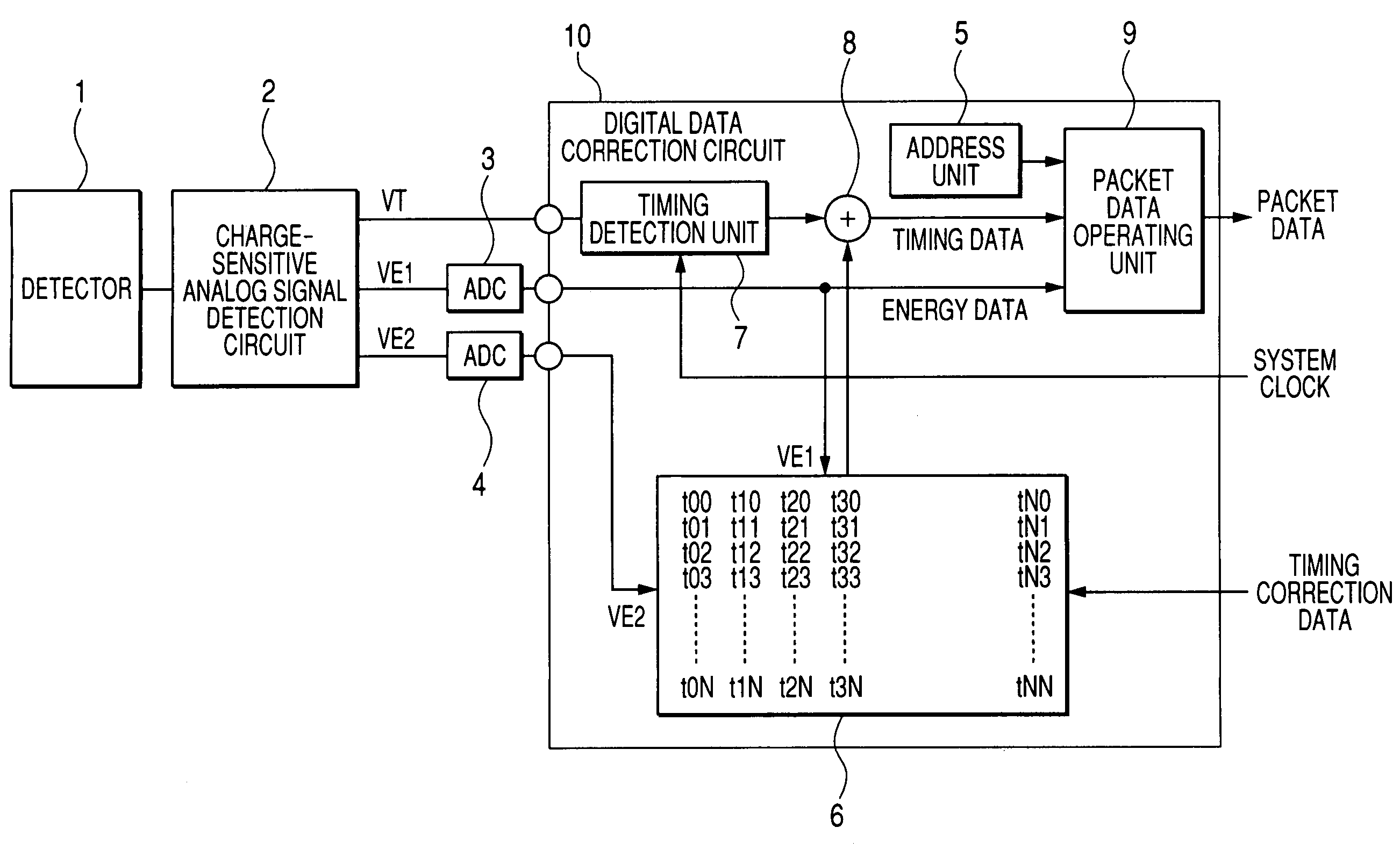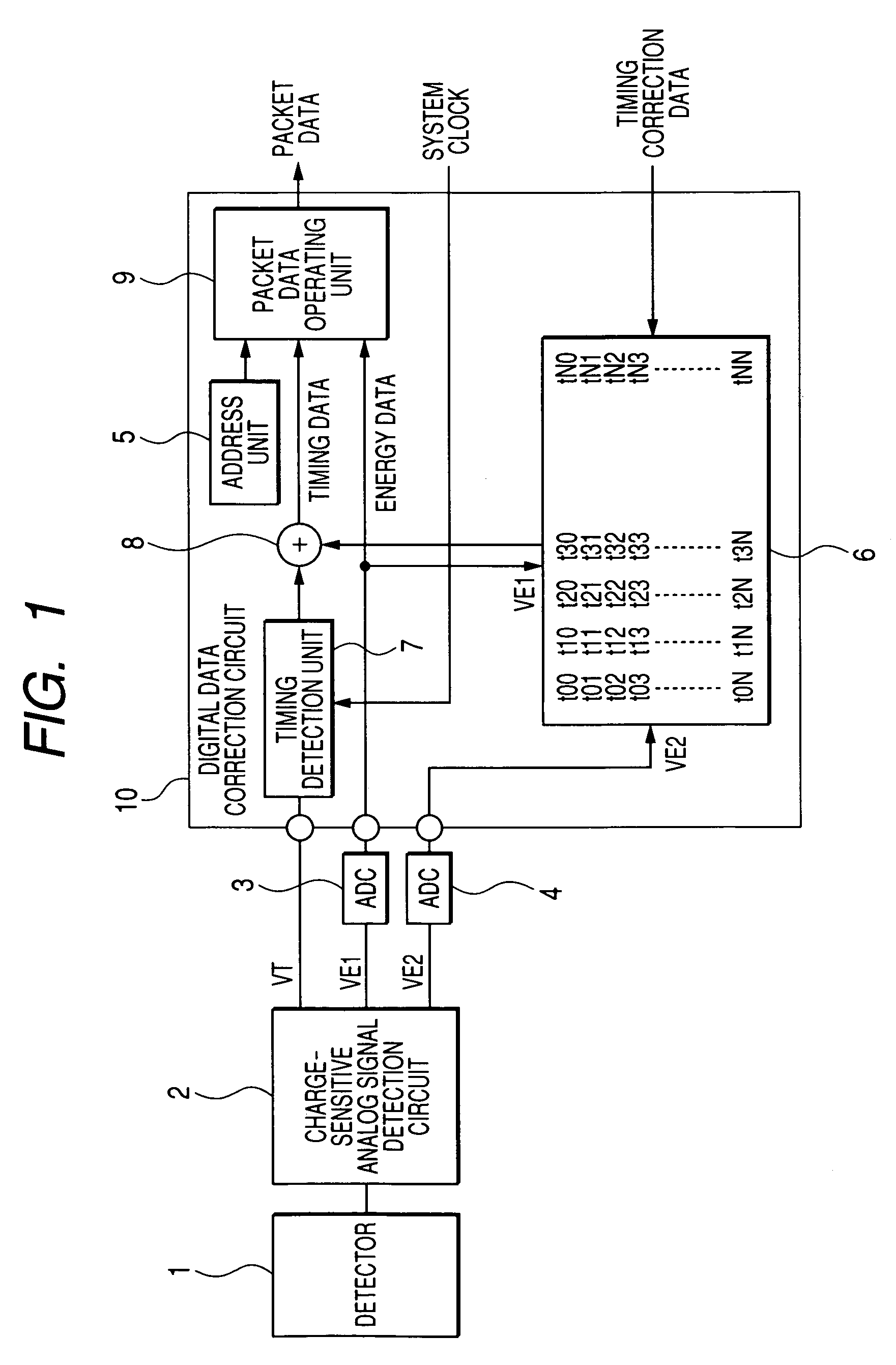Radiation detection circuit and radiological imaging apparatus using the same
a radiological imaging and detection circuit technology, applied in the field of radiological imaging apparatus, can solve the problems of increasing time, reducing the effective count, and hardly practicable medical equipment for semiconductor detectors, so as to improve the contrast of diagnostic images and shorten the diagnostic imaging tim
- Summary
- Abstract
- Description
- Claims
- Application Information
AI Technical Summary
Benefits of technology
Problems solved by technology
Method used
Image
Examples
embodiment 1
[0024]FIG. 1 shows a first embodiment of the radiation detection circuit in the PET / SPECT (Single Photon Emission Computed Tomography) apparatus as an example of the radiological imaging apparatus according to the invention. The PET / SPECT apparatus includes: a detector 1; a charge-sensitive analog signal detection circuit 2; analog / digital converters (ADCs) 3 and 4; and a digital data correction circuit 10. The digital data correction circuit 10 includes: a detector address unit 5; a timing correction data table unit 6; a timing detection unit 7 that converts a timing signal into timing data using a synchronized clock signal from the apparatus; a correction circuit 8; and a packet data generating unit 9. Generally, multiple detectors 1 are provided in the PET / SPECT apparatus so as to surround a test object. Each of all the detectors 1 is connected to the corresponding charge-sensitive analog signal detection circuit 2 on a one-to-one basis. The charge-sensitive analog signal detecti...
embodiment 2
[0043]FIG. 9 shows another embodiment of the construction of the timing correction data table unit 6 concerning the coincidence measurement in the radiological imaging apparatus using the semiconductor detector according to the invention. Embodiment 2 differs from embodiment 1 in that external memory is used for the timing correction data table unit 6 in the digital data correction circuit 10 according to embodiment 1. This aims at solving a problem where the table is too large to be stored in the digital data correction circuit 10. The PET / SPECT apparatus is composed of the detector 1, the charge-sensitive analog signal detection circuit 2, the analog / digital converters (ADCs) 3 and 4, the digital data correction circuit 10, and external memory 21. The digital data correction circuit 10 is composed of the detector address unit 5, the external memory control unit 20, a timing conversion circuit 7, the correction circuit 8, and the packet data generating unit 9. The timing conversion...
embodiment 3
[0045]FIG. 10 shows still another embodiment of the timing signal correction method concerning the coincidence measurement in the radiological imaging apparatus using the semiconductor detector according to the invention. Embodiment 3 differs from embodiment 1 in that the timing signal correction uses digital calculation instead of the table lookup method. That is, the timing correction data table unit 6 is replaced by a timing correction operating unit 22. The PET / SPECT apparatus is composed of the detector 1, the charge-sensitive analog signal detection circuit 2, the analog / digital converters (ADCs) 3 and 4, and the digital data correction circuit 10. The digital data correction circuit 10 is composed of the detector address unit 5, the timing correction operating unit 22, the timing conversion circuit 7, the correction circuit 8, and the packet data generating unit 9. The timing conversion circuit 7 converts a timing signal into timing data according to the clock signal synchron...
PUM
 Login to View More
Login to View More Abstract
Description
Claims
Application Information
 Login to View More
Login to View More - R&D
- Intellectual Property
- Life Sciences
- Materials
- Tech Scout
- Unparalleled Data Quality
- Higher Quality Content
- 60% Fewer Hallucinations
Browse by: Latest US Patents, China's latest patents, Technical Efficacy Thesaurus, Application Domain, Technology Topic, Popular Technical Reports.
© 2025 PatSnap. All rights reserved.Legal|Privacy policy|Modern Slavery Act Transparency Statement|Sitemap|About US| Contact US: help@patsnap.com



